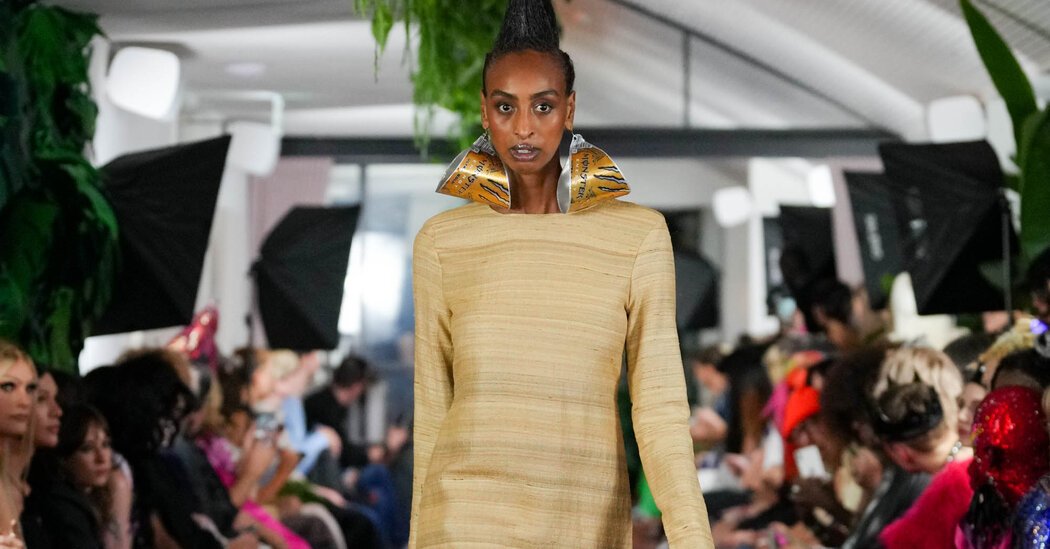[ad_1]
A bride, decked in wedding finery, is traditionally the last model to appear during a live fashion show. But at Vin + Omi, the finale of its spring 2024 show in September during London Fashion Week, was a floor-length, long-sleeve column gown made from the giant butterbur plants grown on the Sandringham estate of King Charles III.
It has “a wonderful feel of silk,” said Vin Cara, who was joined by Omi Ong on a recent video call from Spain, where they were filming a documentary on sustainable innovations around the world. “It’s very regal.”
The giant-butterbur fabric was the latest in a continuing collaboration between the duo and the royal estates, which have included the development of 10 new textiles from materials such as nettles and willow cuttings.
While none of the fabrics have gone into commercial production, garments made from nettles are in the permanent collection of the Victoria and Albert Museum in London. Another is part of the collection of National Museums Scotland and will be on display in Edinburgh through Sunday. The giant-butterbur dress now is in storage while the designers determine where it should be archived.
They met the king, who was then the Prince of Wales, at a June 2018 cocktail reception in support of sustainable fashion. “He asked us what we were doing,” said Mr. Cara, “and at that time we were looking at U.K. country estates” and wondering what was done with their plant waste.
He “was really interested,” Mr. Cara said, and he invited them to collect plants at his Highgrove estate in Gloucestershire, which adheres to organic gardening principles. King Charles is an ardent environmentalist, known throughout much of his life for his concerns about climate change and environmentally sensitive care of the land.
In recent years the fashion industry has become increasingly interested in alternate sources of material production, such as using mushrooms or pineapple leaves to produce faux leathers.
“It’s accelerated so rapidly,” said Claire Lerpiniere, an associate professor of sustainable textiles at De Montfort University’s School of Fashion and Textiles in Leicester, England. “This has become like an actual business.”
Although neither man had formal fashion training — Mr. Cara has a corporate background and in sculpture, and Mr. Ong worked as a photographer and journalist — they both were bothered by the waste they had seen in the industry since founding their privately funded brand in 2000.
During a visit to Sandringham in February, they noticed that giant butterbur covered about a quarter of a lake in front of the house and needed to be cut. The perennial, which has the botanical name Petasites japonicus, is native to Asia, can grow to nearly five feet tall and has kidney-shape leaves that can be as wide as four feet in diameter.
“That was ideal,” Mr. Cara said, “for us to experiment with” because the plants needed trimming, and because the designers work only with waste materials.
“The fibers of that sort of long-stemmed, broad-leaf plant is often suitable for weaving into textiles,” he noted.
The pair collected a few hundred leaves, totaling about six kilograms (13.2 pounds), and then used a process called retting to extract the long fibers, putting the leaves outside in the morning so the dew would wet them and eventually the parts they didn’t want would rot away. The long stringy fibers that remained then were twisted together, using a plant-based bonding material, to form a yarn that their six staff members wove on hand looms to produce four meters, or almost 4.5 yards, of fabric that was 1.37 meters wide. The work took about four months.
“It was just kind of a classic fabric,” said Mr. Cara, which “produces a classic dress.” The fabric was a natural golden shade, as they used no chemicals to treat it, and the gown was made with only six seams to limit the amount of energy used on its assembly.
Nina Marenzi, founder of Future Fabrics Expo, an annual event in London that showcases sustainable material solutions, said such innovations as the butterbur fabric were “just a great way of communicating what is possible,” and that it was important to “shift the kind of collective consciousness and get everyone to not just realize what is possible but also let them dream a bit more.”
[ad_2]
